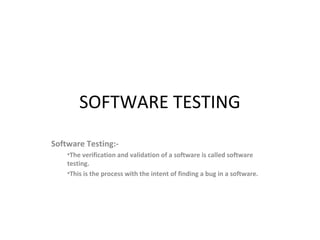Software testing involves verifying and validating software to find bugs. There are different types of testing techniques including static testing, dynamic testing, black box testing, and white box testing. Black box testing focuses on functionality without knowledge of internal design or code. It involves techniques like error guessing, equivalence partitioning, and boundary value analysis. White box testing uses programming knowledge to test internal logic and structures. Common types of testing include unit testing, integration testing, and security testing.

























































